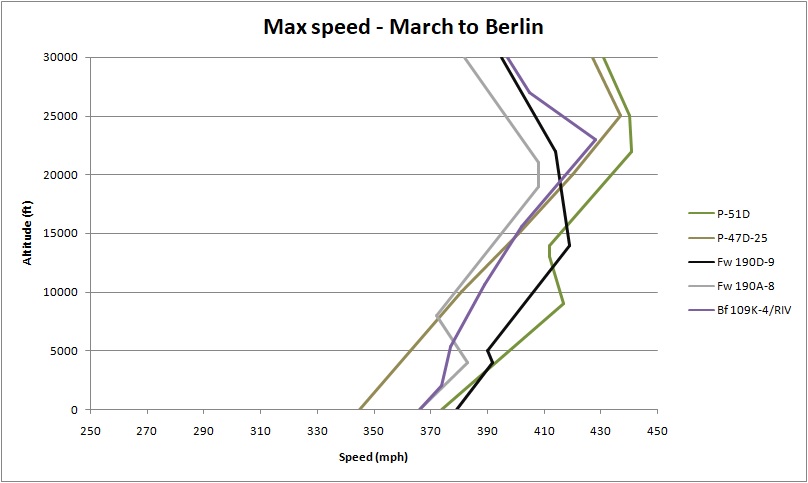<S>
Here is a fighter comparison for the adversaries in the March on Berlin S3 series. In the graph further down I've only included the most commonly used fighters in the series, as to not make it to cluttered.
ALLIES
P-51D
The Mustang is a fast and sleek plane, and can outrun all Axis fighters above 15000 ft at it's top speed. Be aware though that if getting slow in the P-51D, the lighter Axis planes will out-accelerate the Mustang and it will take some time to build up a speed advantage. Against the Fw 190D-9 it also holds a speed advantage between 5000-11000 ft, but should avoid fighting the D-9 at the deck or right at 14000 ft. At high altitudes the P-51D can easily out turn the Fw 190, and above 320 mph IAS it can even out turn the Bf 109. The Bf 109 easily turns inside the P-51 at slower speeds though. General rule of thumb is: The higher the Mustang flies above 23000 ft, the larger the speed advantage it has against the Axis fighters.
P-47D
The Jug is large and heavy. It can endure more damage than most WW2 fighters, but does not stand a chance in a turn fight against the smaller German fighters, and is at a speed disadvantage below 15000 ft. At high altitudes this is a great escort fighter though, able to outrun and dominate it's Axis adversaries above 25000 ft. With disciplined wingman tactics this plane is quite dangerous with it's 8x .50 cals. Avoid low altitude fighting like the plauge when flying the Jug. A good defensive tactic if alone against a Bf 109 is to dive above 350 mph IAS and then make a sharp turn. The Bf 109 will have a hard time to follow as it's elevator gets heavy at high speeds.
(Of note: After this S3 series the P-47D-25 might be remodeled to use 150 grade (44-1) fuel, just like the P-51D, giving it a top speed similar to the Mustang above 15000 ft. Currently it's limited to a WEP of 65" Hg with 100/130 fuel).
P-38L
The Lightning's Allison V-1710-111/113 engines are tooled for high altitude, and it can even outrun the Bf 109K-4 above 27000 ft. Below this altitude the late war Axis fighters are faster. The P-38 can out turn the Fw 190, but not the Bf 109. The P-38 is great for Jabo missions, due to it's heavy bomb loadout options, but just like the P-47, this plane should really avoid low altitude fighting like the plauge and only to Jabo missions where enemy fighters are unlikely to be encountered. If fighting above 25000 ft this fighter can make a good account of itself though, even against Axis late war opponents.
Spitfires
The Spitfire XIVe is probably the best overall dogfighter in the game. It has a very similar top speed to the P-51D up to 20000 ft, and above this altitude it is faster than the Mustang and all Axis fighters. While it is sometimes matched by other fighters in certain aspects, it can generally outperform these planes in the other aspects, allowing a skilled Spitfire XIVe pilot to always find a way to outfight all enemies in a 1v1, if he knows how to use his and and his enemy's strengths and weaknesses. The Spitfire IXe has a tighter turning radius than the Spitfire XIVe, but has a lower top speed. German late war fighters can use boom and zoom tactics against the IXe if flying disciplined.
AXIS
Fw 190D-9
The D-9 uses the Jumo 213A inline engine and is faster than the A-8, but has only 2x20 mm cannons. The Dora can run with the Mustang up to 15000 ft (4600 m) and easily outruns the P-38 and P-47 below this altitude. Above 20000 ft (6100 m) the Allied escort fighters are faster. The Dora generally struggles in a turn fight against the P-51 or P-38, but can outturn the P-47, except at very high altitudes where the Jug has a large engine power advantage. The D-9 is the best anti-fighter choice among the Focke Wulfs, and has a small pocket window at 14000 ft where it can outrun the P-51D before the Mustang's second supercharger gear kicks in. As such a Dora in trouble does best to dive to 14000 ft and then try to escape at this altitude.
Fw 190A-8
The A-8 is slower than the D-9, and is generally slower than most Allied fighters. It's benefits is the extra cannons, and especially the Sturmbock loadout which gives the A-8 "Butcherbird" one of the highest damage outputs in Warbirds. The engine is also protected by heavy 10 mm armor plates, which makes it harder for enemy bombers to kill the engine of the A-8. This coupled with it's heavy armament makes the A-8 the ideal bomber killer, while it's not as good in a fighter vs fighter role as the D-9.
Bf 190K-4
The Messerschmitt can out turn all the American escort fighters at low speeds and is also the best climber. Against a Spitfire XIV though it's more hazardous to turn fight. The elevator becomes very heavy with increasing airspeed and this significantly affect's the Bf 109's turning ability at high speeds. It's top speed is quite good up to 23000 ft (7000 m), from where it's DB 605DB engine starts to lose power. The 'Scmitt is inferior to the Allied fighters above this altitude. The MK 108 30-mm cannon has a higher damage output than the 20 mm but is harder to hit with. It is a great weapon against static bombers. The K-4/RIV has two extra gondola cannons in the wings. This increases the firepower greatly, at a cost of a heavier weight, slower roll rate, and a 5-7 mph (8-11 kmh) decrease in top speed. The G-14 is 6-12 mph slower than the K-4, depending on altitude, but otherwise very similar in handling.

<S>
/Robert
